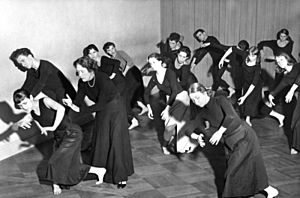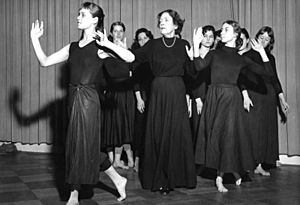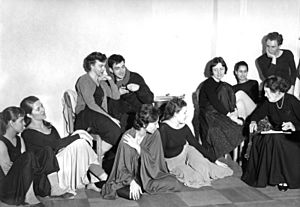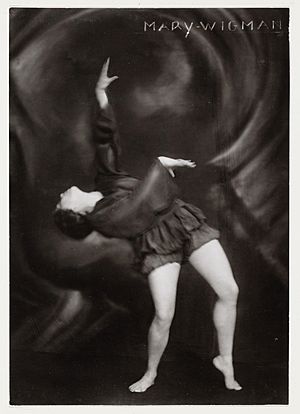Mary Wigman facts for kids
Quick facts for kids
Mary Wigman
|
|
|---|---|

Mary Wigman (left)
|
|
| Born |
Karoline Sophie Marie Wiegmann
13 November 1886 |
| Died | 18 September 1973 (aged 86) |
| Nationality | German |
| Known for | modern dance and dance therapy |
| Movement | Expressionist dance |
Mary Wigman (born Karoline Sophie Marie Wiegmann; November 13, 1886 – September 18, 1973) was a famous German dancer and choreographer. She was a pioneer of expressionist dance, a style that focuses on expressing feelings and ideas. She also helped start dance therapy, which uses movement to help people feel better. Mary Wigman is known as one of the most important people in the history of modern dance. Her work was celebrated for showing deep human feelings on stage.
Contents
Mary Wigman's Life and Dance Journey
Karoline Sophie Marie Wiegmann was born in Hanover, Germany. She started dancing later in life after seeing students of Émile Jaques-Dalcroze. His method, called eurhythmics, taught people to understand music through movement. Wigman joined his school in Dresden in 1911.
However, at this school, dance was less important than music. So, Wigman looked for other ways to explore dance. In 1913, she met Rudolf von Laban, another important dance teacher. She joined his summer courses in Switzerland. Laban taught a technique based on contrasting movements, like expanding and contracting, or pushing and pulling. Wigman worked as Laban's assistant until 1919.
After leaving Laban's school, Wigman went to the Swiss mountains. There, she developed her own unique style of dance. She called it "New German Dance." This name showed that it was different from traditional ballet. She wanted her dance to show human desires, feelings, and inspirations. She believed any movement could be dance if it expressed a true feeling. Her style often included movements like sliding, bouncing, vibrating, and falling.
In 1919, Wigman performed her first solo concerts in cities like Berlin and Hanover. At first, people didn't like them much. But later that year, she received great praise in Hamburg and Zurich. By the mid-1920s, her name was linked to "Ausdruckstanz," which means Expressionist Dance in Germany.
In 1920, Wigman opened her own dance school in Dresden. It became known as the "Mary Wigman-Schule." This school quickly became the main place for new, expressionist dance in Germany. Many famous dancers and choreographers studied there. Some of her students included Hanya Holm, Harald Kreutzberg, and Gret Palucca. Mary Wigman also taught international students, like Pola Nirenska and Meta Vidmar, who later opened modern dance schools in other countries.

Mary Wigman and her dance company toured the United States in the early 1930s. Her student, Hanya Holm, helped spread Wigman's dance style in America. Wigman's movement and training methods were even used in German public schools. In the early 1930s, the German government officially honored her achievements.
The "Mary Wigman-Schule" operated from 1920 until 1942. When World War II began, the Nazis in Germany saw her as someone who didn't fit their ideas. They thought her dances were "degenerate," meaning they were not good or pure. The Nazis closed her school, but she was allowed to teach in Leipzig during the war. To continue teaching, she had to follow strict government rules.
After the war, her school was reopened by Dore Hoyer. Wigman continued teaching in Leipzig until 1949. From 1950 until her death in 1973, she taught at her new school in West Berlin. This school became a place where modern dancers from all over the world could meet and share ideas. Her last public performance was in 1953.
Mary Wigman's Work and the Nazi Era
During the time when the Nazi Party was rising in Germany, Mary Wigman's dance style became very popular. The Nazis liked "Ausdruckstanz," or the new German Dance, because they thought it showed German values. They believed dance could help protect German culture from outside influences.
Some records from the Nazi government show that Wigman's school was seen as one of the "model schools of German art dance." This means her work fit into the Nazi idea of what German art should be. Her dance style helped create a sense of community among Germans.
It's debated whether Mary Wigman personally supported the Nazis. Some believe she might have agreed with some conservative ideas that helped the Nazis rise to power. Others think she might not have realized how her work was being used to support Nazi ideas. However, her dance style was definitely used by the Nazis to promote their ideas of German identity and community.
Mary Wigman's Dance Productions
Mary Wigman gave her first public performance in Munich in 1914. She performed two of her own dances, including an early version of Hexentanz (Witch Dance). This dance later became one of her most famous works.
In 1918, Wigman created the choreography for her first group dance, Die sieben Tänze des Lebens (The Seven Dances of Life). It premiered in 1921. After this, her career really took off.
Wigman's dances often used world music and instruments from different cultures. She used fifes and mostly percussion instruments, like bells, gongs, and drums from places like India, Africa, and China. Sometimes, her dances were performed in complete silence. Later, she started working with composers to create music specifically for her dances.
She often used masks in her performances, inspired by non-Western and tribal dances. Her costumes were not like the typical ones used in ballet. The topics of her dances were often serious, like the death and sadness that came with war. However, she didn't just show what happened in the war. Instead, she danced to express the deep feelings people were experiencing during those difficult times.
Famous Works by Mary Wigman
- Summer Dance
- Dream Image
- Hexentanz (Witch's Dance)
- Totenmal
- Dance of Lorrow
- Visions, Cycles, and the Bay
- Festive Rhythm
- Dance of Spring
Images for kids
-
Commemorative plaque attached to Wigman's former home at Schmiedestrasse 18 in Hannover, Germany
-
Mary Wigman's grave in the family plot at Ostfriedhof in Essen, Germany
See also
 In Spanish: Mary Wigman para niños
In Spanish: Mary Wigman para niños









